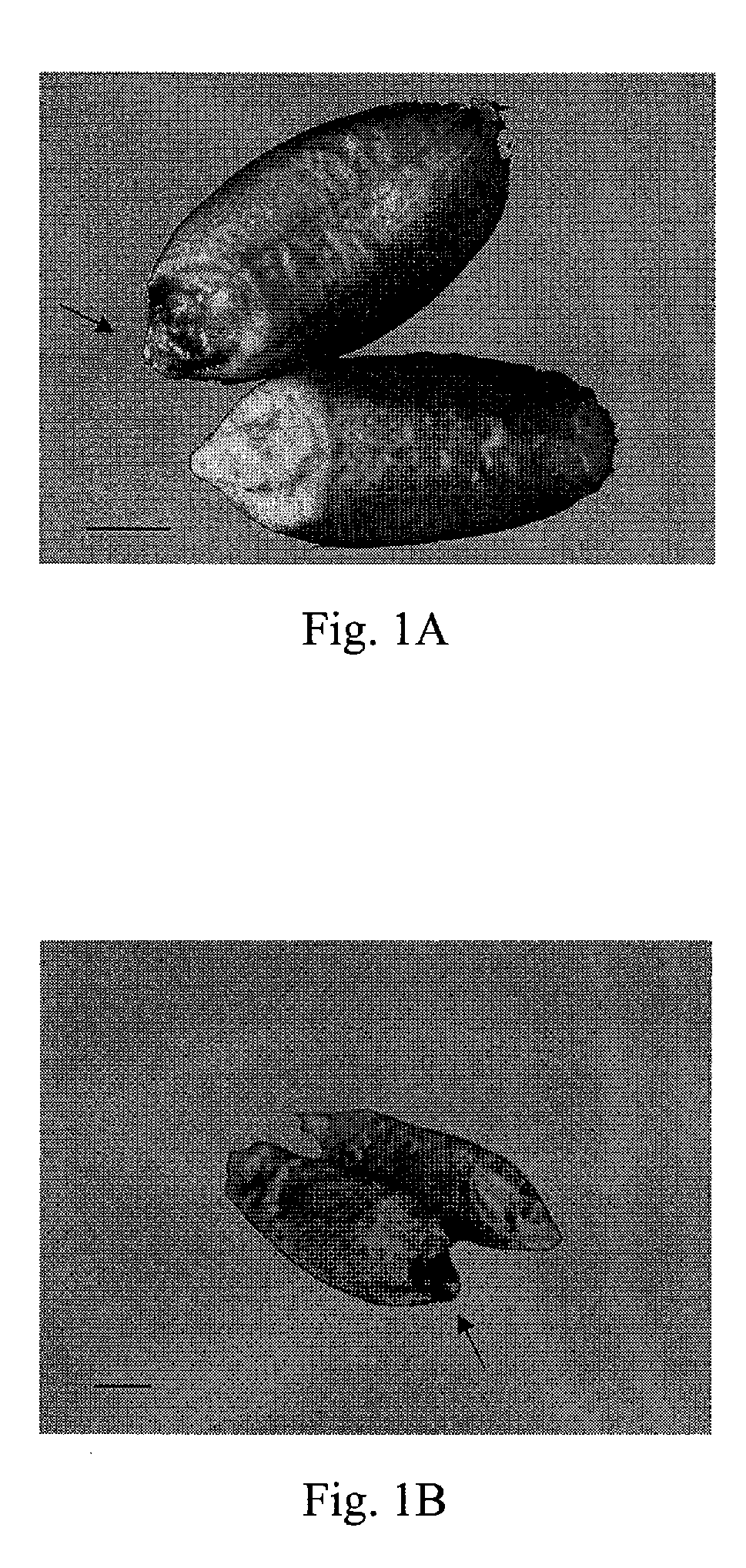Identity preservation system for transgenic wheat and triticale
a technology of identity preservation and transgenic wheat, which is applied in the field of identity preservation for cereal crops, can solve the problems of not being suitable for human or livestock ingestion, additional supply costs, and /novel-trait crops or their products being not allowed
- Summary
- Abstract
- Description
- Claims
- Application Information
AI Technical Summary
Benefits of technology
Problems solved by technology
Method used
Image
Examples
example 1
Transfer of Unique Seed Coat Colours from Wheat to Triticale
[0063]Genetic transfer of blue and purple seed coat colour from wheat to triticale was initiated through the use of standard crossing procedures for triticale (Larter and Gustafson, 1980) and wheat (Allan, 1980).
[0064]Both the triticale and wheat plants were grown under greenhouse conditions, with two seeds planted per 1 gallon pot containing Cornell artificial soil mixture. Lighting and temperatures conditions were a 16 photoperiod, with a 21 / 15° C. diurnal temperature. The triticale was common seed of the cultivar AC Alta. The blue and purple wheat were experimental lines designated “Purendo38” and “Purple Bulk”. The blue seeded wheat, “Purendo38” was obtained from Dr. Pierre Hucl of the University of Saskatchewan, College of Agriculture. Department of Plant Sciences. The purple seeded wheat, designated “Purple Bulk”, was a composite of several early generation plants exhibiting purple seed coat colour, derived from a bac...
example 2
Anthocyanin Expression in Transgenic Wheat and Triticale Embryos (Purple Visible Embryo Marker)
[0083]According to the present invention, we report the recovery of anthocyanin expressing embryo in mature seeds of wheat (Triticum aestivum L.) and triticale (XTritiosecale) lines, without using the selectable marker gene.
[0084]Plasmid pLtp1CB, which carries C1 (NCBI reference AF320613; AF320614) and Bperu (NCBI reference X57276; X70791) anthocyanin biosynthesis genes driven by barley Ltp1 embryo specific promoter (GenBank Accession No. X60292) was cloned in E. coli DH5α and purified using QIAGEN Plasmid Maxi kit (QIAGEN Inc., Mississauga, ON, Canada, Cat. No. 12162). The original constructs carrying C1 and Bperu genes is from Chawla et al. 1999. The resulting DNA pellet was resuspended in TE buffer (10 mM Tris-HCl, 0.1 mM EDTA, pH 8.0) and the gene cassette was excised by doubled digesting plasmid DNA with BamH1 and Sph1 restriction enzymes. Once the 5.45 kb DNA fragment was gel purifie...
example 3
Crossing of 6× (hexaploid) and 8× (octaploid) Triticale for Seed Coat Color
[0090]Following crosses (F1 and BC1) were made:
[0091]Cross 1. 8× triticale 89TT108 (Female)×6× triticale blue TTT B-6-15 (Male)
[0092]Twenty eight seeds were obtained by this cross and all F1 seeds were blue in color (observed xenia effect, as the male parent had blue seed color), which suggests that blue seed color is dominant over red seed color.
[0093]Cross 2. 8× triticale 90CT1ROW397 (Female)×6× triticale blue TTT B-6-15 (Male)
[0094]Thirty two seeds were obtained by this cross and all F1 seeds were blue in color (observed xenia effect, as the male parent had blue seed color), which suggests that blue seed color is dominant over red seed color.
PUM
| Property | Measurement | Unit |
|---|---|---|
| Threshold limit | aaaaa | aaaaa |
Abstract
Description
Claims
Application Information
 Login to View More
Login to View More - R&D
- Intellectual Property
- Life Sciences
- Materials
- Tech Scout
- Unparalleled Data Quality
- Higher Quality Content
- 60% Fewer Hallucinations
Browse by: Latest US Patents, China's latest patents, Technical Efficacy Thesaurus, Application Domain, Technology Topic, Popular Technical Reports.
© 2025 PatSnap. All rights reserved.Legal|Privacy policy|Modern Slavery Act Transparency Statement|Sitemap|About US| Contact US: help@patsnap.com

